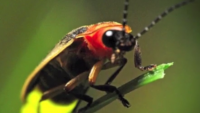Hades Centipede: 3 Things You Should Know About This Arthropod From Hell
| Quadey Humile | | Jul 02, 2015 10:40 PM EDT |
(Photo : Youtube) Meet Hades centipede, the so-called arthropod from hell.
A new breed of centipede, commonly called Hades centipede, has been discovered deep down a cave by members of the Croatian Biospeleological Society. Listed below are the three interesting things you should know about this so called "arthropod from hell."
1. Hades centipede's real name
Like Us on Facebook
Hades centipede's real name or rather its scientific name is Geophilus hadesi; it was named after the Greek mythological god of the underworld - Hades, PHYS.ORG has learned.
A member of a particular order called geophilomorphs, Hades centipede is a terrestrial arthropod belonging to the Chilopoda class of the subphylum Myriapoda.
2. Hades centipede's habitat
Geophilus hadesi was discovered by researchers in the deep caves of Croatia's Velebit mountains, CBC News reported.
Unlike most centipedes under the Geophilomorpha order that rarely seek shelter in caves, the Hades centipede's life cycle is spent entirely in the dark, underground environment, thus, it was named after Hades.
Like Hades, the arthropod has its queen of the underworld - Geophilus persephones which was first discovered in a cave in France in the 1990s.
As a matter of fact, G. hadesi was named with its mythical queen in mind as per Pavel Stoev, the lead author of "Creepy Crawlies & Flying Wonders: Incredible Cave Creatures," a paper detailing the new centipede breed - and associate professor of zoology at the National Museum of Natural History in Sofia, Bulgaria.
Researchers reportedly recorded G. hadesi living as far as 1,100 meters below the surface of the Earth.
3. Hades centipede's physical characteristics and diet
Hades centipede's bodily features are so designed to help it survive in a deep and dark environment.
It has a long, flat body which makes crawling around rocky cave crevices easy. It has 33 pairs of legs with fine claws. Furthermore, it has "exceptionally elongated" antennae and furlike body hair which allow it to detect prey in complete darkness, Stoev reportedly said.
Like majority of the centipede population, G. hadesi feeds on live animals such as worms, spiders, larvae and other small prey.
Despite being venomous, this so called "arthropod from hell" is likely completely harmless to humans, Stoev said according to Yahoo.News.
The discovery and study results of G. hadesi were published in the journal "ZooKeys" on June 30.
©2015 Chinatopix All rights reserved. Do not reproduce without permission
EDITOR'S PICKS
-

Did the Trump administration just announce plans for a trade war with ‘hostile’ China and Russia?
-

US Senate passes Taiwan travel bill slammed by China
-

As Yan Sihong’s family grieves, here are other Chinese students who went missing abroad. Some have never been found
-

Beijing blasts Western critics who ‘smear China’ with the term sharp power
-

China Envoy Seeks to Defuse Tensions With U.S. as a Trade War Brews
-

Singapore's Deputy PM Provides Bitcoin Vote of Confidence Amid China's Blanket Bans
-

China warns investors over risks in overseas virtual currency trading
-

Chinese government most trustworthy: survey
-

Kashima Antlers On Course For Back-To-Back Titles
MOST POPULAR
LATEST NEWS
Zhou Yongkang: China's Former Security Chief Sentenced to Life in Prison

China's former Chief of the Ministry of Public Security, Zhou Yongkang, has been given a life sentence after he was found guilty of abusing his office, bribery and deliberately ... Full Article
TRENDING STORY

China Pork Prices Expected to Stabilize As The Supplies Recover

Elephone P9000 Smartphone is now on Sale on Amazon India

There's a Big Chance Cliffhangers Won't Still Be Resolved When Grey's Anatomy Season 13 Returns

Supreme Court Ruled on Samsung vs Apple Dispute for Patent Infringement

Microsoft Surface Pro 5 Rumors and Release Date: What is the Latest?















